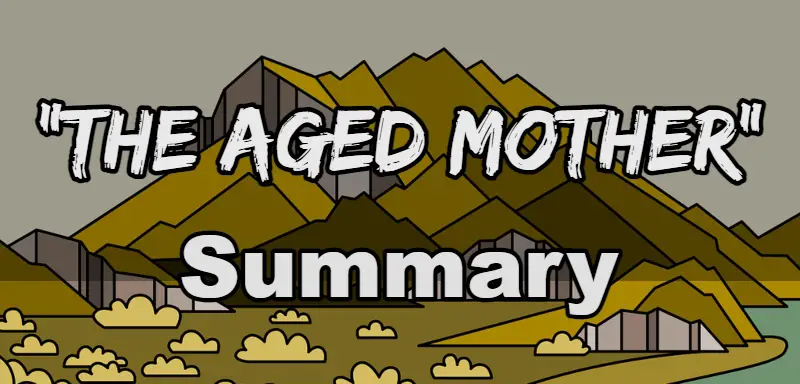“The Aged Mother” Summary
A poor farmer lives with his aged mother at the foot of a mountain. They grow a little food and are happy.
The governor of the province, though a brave warrior, is afraid of weakness and sickness. He issues an order that all elderly people in the province are to be killed. The poor farmer loves his aged mother, but disobeying the leader’s edict is out of the question. Full of sorrow, he prepares to carry out the order in the most humane way he can.
After work at sundown, he cooks and dries some rice, then ties it in a cloth. He fills a gourd with water. He ties both into a bundle and puts it around his neck. He puts his aged mother on his back and starts up the mountain.
The road up the mountain is long and steep with crisscrossing paths—it’s not always clear which way to go. The farmer presses on, heading upward toward the summit of the mountain.
His aged mother notices the confusing pattern of trails and worries that his descent will be dangerous. She starts snapping off twigs as they go and then drops them into little piles at intervals.
They reach the top. Tired and heartsick, the farmer prepares a soft place with pine needles for his aged mother to sit. He says a tearful goodbye.

With love, his aged mother instructs him to be careful on the way down and follow the piles of twigs until he reaches familiar ground. Surprised, the son notices her old, scratched hands from the work. Moved by her concern, he breaks down and says he won’t leave her behind. He’s willing to die with her if it comes to that.
He picks her up and carries her back down the mountain to their small hut. He hides her in the little food cellar under the kitchen floor. He takes care of her, but worries she’ll be discovered.
After a while, the governor issues another edict—he wants the citizens to present him with a rope of ashes. Everyone is afraid, as no one knows how to make such a thing.
The farmer passes on the terrible news to his aged mother. She thinks for two days then tells him how to do it—make a rope of twisted straw, lay it out on stones, and burn it on a windless night. The farmer gets the people together and they carry out the plan, which results in a rope of ashes.
Pleased, the governor wants to know how the farmer figured it out. Moved to tell the truth, the farmer relates the story of his aged mother. After some thought, the governor realizes the province needs more than the strength of youth; it also needs the wisdom of age. He abolishes the law against the elderly. Only legends of this old custom remain.
(End of “The Story of the Aged Mother” Summary)
“The Story of the Aged Mother” Commentary
There are two clearly prominent themes in the story—unselfish love and the wisdom of age.
The unselfish love between the mother and son is quickly established and then escalates throughout. First, the son is deeply grieved by the ruler’s order and puts resources and work into doing it in a humane way. He prepares food and water and then carries them and his mother far up into the mountains.
We might wonder how much the son loves his mother if he’s willing to abandon her to die in the mountains. Disobeying the ruler’s edict is not something he would consider. His orders are absolute. If he disobeys, they would both be killed anyway. It’s evident that the mother understands the hopelessness of the situation as well. She doesn’t even suggest that they disobey the order.
Second, the mother, while knowing she’s being carried away to her death, is focused on her son’s safety. She worries about him getting lost on the way back, which could result in his death, or at least some suffering. She scratches her hands up with the twigs she drops to help lead him back down the trail. (This also highlights her wisdom, contrasting it with her limited physical abilities. A young person, trusting in their physicality, could easily overlook the potential danger in this situation. She uses the little physical ability she has to break the twigs and drop them.)
Lastly, the son is so moved by his mother’s concern for him in the face of her unjust death that he can’t go through with it. He decides to hide her in the cellar and risk his own death.
The theme of the wisdom of age takes over the rest of the story. When the ruler issues an arbitrary and seemingly impossible order—to present him a rope of ash—only the aged mother, the only remaining elderly person in the area, can come up with a solution. Although she’s physically incapable of carrying out the plan, her contribution is highly valuable.
When the ruler finds out she was the one who figured it out, he realizes that strength and youth aren’t everything. This lesson is directly stated at the end of the story, and is its main theme.
I hope this summary of “The Story of the Aged Mother” by Matsuo Bashō, and a look at its themes was helpful.